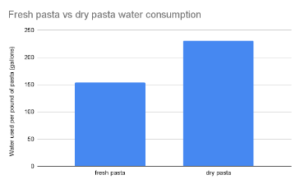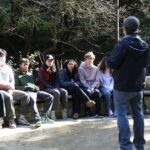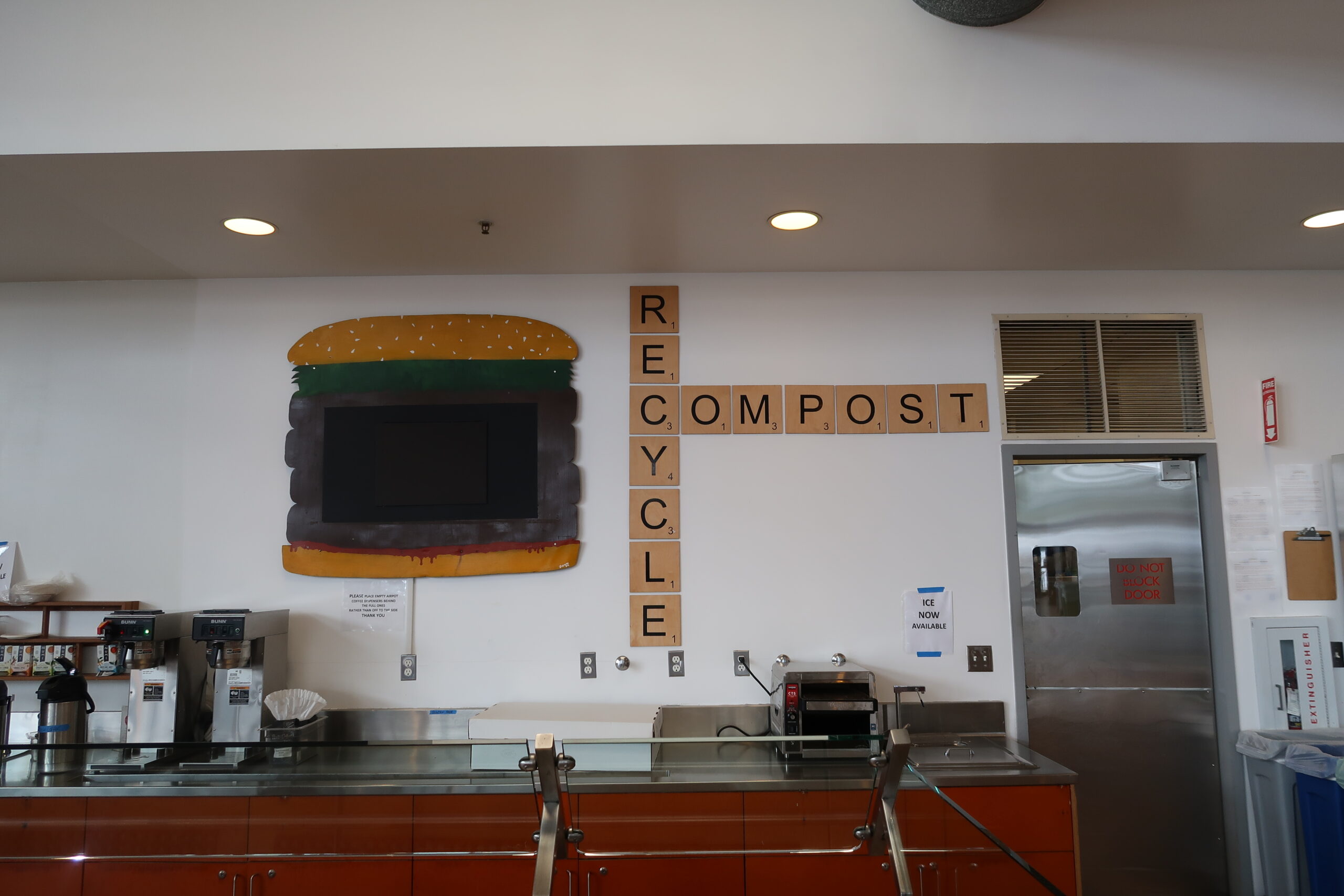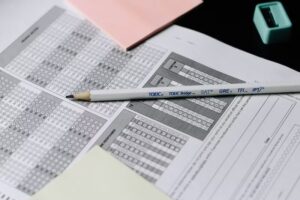Lick-Wilmerding High School’s Ann Maisel Cafe, nicknamed the Caf, stands at the forefront of an effort for sustainable food practices in school cafeterias nationwide.
LWHS students in the Statistics PPP class took a deeper dive into the issue of Caf sustainability this fall. Each group of students was assigned to an LWHS-specific issue to research, and Alec Miyashita ’24 and Max Webb ’24 were among those researching the water usage for LWHS lunches. They shared their findings with their Statistics PPP class in the form of a slideshow.
Miyashita and Webb initially planned on researching the general carbon footprint of the Caf, but ultimately decided to zoom in on water usage as they believed that it would be easier to find actual numbers. The pair searched for average water usage numbers, such as the amount of water used to make a single hamburger patty.
Miyashita and Webb learned that LWHS sources all of their beef from Corfini meats, which is 100% grass fed. Grass fed beef uses nearly one half of the amount of water that factory farmed beef uses.

graph by LWHS Statistics PPP
The LWHS Caf is also tasked with following a sustainable food preparation process. “We are one of the very few scratch cooking kitchens left anywhere, even in private schools,” said Kathleen Fazio, LWHS Director of Food Services. This means that nearly 90% of the food served in the Caf is made from whole and raw ingredients. “I don’t buy buckets of prepped vegetables, nothing. It’s all [from] scratch,” Fazio said.
While most lunches are made from scratch, lunches like pesto pasta are bought from local suppliers. The LWHS Statistics PPP class found that pesto pasta days call for a hefty 120 pounds of dry pasta. Each pound of dry pasta requires 230.5 gallons of water, in comparison to 153.7 gallons of water to produce a pound of fresh pasta.

graph by LWHS Statistics PPP
In addition to cooking most lunches from scratch, Fazio is tasked with balancing authenticity, flavor and sustainability as she plans for each meal. “Everything has to taste authentic, so today we’re doing jambalaya and it has to taste like you’re sitting in New Orleans eating jambalaya,” she said. As much as Fazio hopes that the flavors of her food can transport students to a new place, she tries to keep her ingredients as local as possible.
“Environmental impact is a huge driving force here. One of the reasons I do everything from scratch is because I want to know what happened to stuff before it got here. I try to shop organic as much as possible, but I would rather have commercial and local than burn the fossil fuels of getting something from Chile — the furthest point South,” Fazio said.
Not only is Fazio conscious of the life of the food before it reaches students’ plates, but she also aims to minimize food waste. “Something can almost always become something else. Last week we made a really great salad for the salad bar — I put mixed cruciferous vegetables to see how many people would say ‘what the hell is a cruciferous vegetable?’ And there wasn’t a lot left, but the next day, I said to my chef, ‘put that slaw into the vegan pulled pork! Everything is shredded, it’s a bunch of different root vegetables, all the stems and everything, just incorporate them in there!’” Fazio said that she would never compost something that is edible.
However, the environmental consciousness that happens in the kitchen does not always translate to the tables. Fazio said that she goes “dumpster diving” for twenty minutes each day and continues to pull butter wrappers, sauce packets and chip bags from the compost bin. “It would be really easy for the student body to be more attentive. It would save the planet, it would save people a ton of work, and, last of all, there would never be a butter wrapper in the compost bin!” she said.








Escort Gazette review guide with free verified ads in Europe. Best Escort Girls, Strip clubs, Brothels, Massage parlors on the map. Easy search directory. https://http-directory.com/listings12682417/best-escort-girls-strip-clubs-brothels-massage-parlors-on-the-map-easy-search-directory
Escort Gazette review guide with free verified ads in Europe. Best Escort Girls, Strip clubs, Brothels, Massage parlors on the map. Easy search directory. https://louiso814xjv1.ageeksblog.com/profile
Escort Gazette review guide with free verified ads in Europe. Best Escort Girls, Strip clubs, Brothels, Massage parlors on the map. Easy search directory. https://manueljwiu13689.ttblogs.com/5785185/escort-gazette-review-guide-with-free-verified-ads-in-europe
Escort Gazette review guide with free verified ads in Europe. Best Escort Girls, Strip clubs, Brothels, Massage parlors on the map. Easy search directory. https://socialmediainuk.com/story17133268/escort-gazette-review-guide-with-free-verified-ads-in-europe
Escort Gazette review guide with free verified ads in Europe. Best Escort Girls, Strip clubs, Brothels, Massage parlors on the map. Easy search directory. https://juliusvmyl70257.myparisblog.com/26774587/escort-gazette-review-guide-with-free-verified-ads-in-europe
Escort Gazette review guide with free verified ads in Europe. Best Escort Girls, Strip clubs, Brothels, Massage parlors on the map. Easy search directory. https://gogogobookmarks.com/story16947932/escort-gazette-review-guide-with-free-verified-ads-in-europe
Escort Gazette review guide with free verified ads in Europe. Best Escort Girls, Strip clubs, Brothels, Massage parlors on the map. Easy search directory. https://simonbnam70257.blog5star.com/26678351/escort-gazette-review-guide-with-free-verified-ads-in-europe
Escort Gazette review guide with free verified ads in Europe. Best Escort Girls, Strip clubs, Brothels, Massage parlors on the map. Easy search directory. https://jackt025yjt0.tnpwiki.com/user
Escort Gazette review guide with free verified ads in Europe. Best Escort Girls, Strip clubs, Brothels, Massage parlors on the map. Easy search directory. https://dominickwjwi68124.loginblogin.com/32543048/best-escort-girls-strip-clubs-brothels-massage-parlors-on-the-map-easy-search-directory
Escort Gazette review guide with free verified ads in Europe. Best Escort Girls, Strip clubs, Brothels, Massage parlors on the map. Easy search directory. https://tonye479juf4.ja-blog.com/profile
Escort Gazette review guide with free verified ads in Europe. Best Escort Girls, Strip clubs, Brothels, Massage parlors on the map. Easy search directory. https://eternalbookmarks.com/story16874165/escort-gazette-review-guide-with-free-verified-ads-in-europe
Escort Gazette review guide with free verified ads in Europe. Best Escort Girls, Strip clubs, Brothels, Massage parlors on the map. Easy search directory. https://agency-social.com/story2281854/escort-gazette-review-guide-with-free-verified-ads-in-europe
Escort Gazette review guide with free verified ads in Europe. Best Escort Girls, Strip clubs, Brothels, Massage parlors on the map. Easy search directory. https://free-bookmarking.com/story17014472/best-escort-girls-strip-clubs-brothels-massage-parlors-on-the-map-easy-search-directory
Escort Gazette review guide with free verified ads in Europe. Best Escort Girls, Strip clubs, Brothels, Massage parlors on the map. Easy search directory. https://bookmarkvids.com/story17885118/escort-gazette-review-guide-with-free-verified-ads-in-europe
Escort Gazette review guide with free verified ads in Europe. Best Escort Girls, Strip clubs, Brothels, Massage parlors on the map. Easy search directory. https://angeloxkxj69146.arwebo.com/49321584/escort-gazette-review-guide-with-free-verified-ads-in-europe
Escort Gazette review guide with free verified ads in Europe. Best Escort Girls, Strip clubs, Brothels, Massage parlors on the map. Easy search directory. https://rylanxlyk70257.atualblog.com/32239044/escort-gazette-review-guide-with-free-verified-ads-in-europe
Escort Gazette review guide with free verified ads in Europe. Best Escort Girls, Strip clubs, Brothels, Massage parlors on the map. Easy search directory. https://210list.com/story17408546/escort-gazette-review-guide-with-free-verified-ads-in-europe
5zq8qa